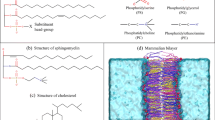Summary
The cytolytic toxin aerolysin was found to form ion channels which displayed slight anion selectivity in planar lipid bilayers. In voltage-clamp experiments the ion current flowing through the channels was homogeneous indicating a defined conformation and a uniform size. The channels remained open between −70 to +70 mV, but outside this range they underwent voltage-dependent inactivation which was observed as open-closed fluctuations at the single-channel level. Zinc ions not only prevented the formation of channels by inhibiting oligomerization of monomeric aerolysin but they also induced a closure of preformed channels in a voltage-dependent fashion. The results of a Hill plot indicated that 2–3 zinc ions bound to a site within the channel lumen. Proaerolysin, and a mutant of aerolysin in which histidine 132 was replaced by an asparagine, were both unable to oligomerize and neither could form channels. This is evidence that oligomerization is a necessary step in channel formation.
Similar content being viewed by others
References
Andreoli, T.E., Troutman, S.L. 1971. An analysis of unstirred layers in series with “tight” and “porous” lipid blayer membranes.J. Gen. Physiol. 57:464–478
Arbuthnott, J.P., Freer, J.H., Billcliffe, B. 1973. Lipid-induced polymerization of staphylococcal α-toxin.J. Gen. Microbiol. 75:309–319
Bashford, C.L., Alder, G.M., Menestrina, G., Micklem, K.J., Murphy, J.J., Pasternak, C.A. 1986. Membrane damage by hemolytic viruses, toxins, complement, and other cytotoxic agents.J. Biol. Chem. 261:9300–9308
Benz, R., Bauer, K. 1988. Permeation of hydrophilic molecules through the outer membrane of gram-negative bacteria.Eur. J. Biochem. 176:1–19
Bhakdi, S., Füssle, R., Tranum-Jensen, J. 1981. Staphylococcal α-toxin: Oligomerization of hydrophilic monomers to form amphiphilic hexamers induced through contact with deoxycholate detergent micelles.Proc. Natl. Acad. Sci. USA 78:5475–5479
Bhakdi, S., Tranum-Jensen, J. 1987. Damage to mammalian cells by proteins that form transmembrane pores.Rev. Physiol. Biochem. Pharmacol. 107:147–223
Buckley, J.T., Howard, S.P. 1988. Aerolysin fromAeromonas hydrophila.Methods Enzymol. 165:193–199
Cass, A., Finkelstein, A. 1967. Water permeability of thin lipid membranes.J. Gen. Physiol. 50:1765–1784
Catterall, W.A. 1988. Structure and function of voltage-sensitive ion channels.Science 242:50–61
Chakraborty, T., Huhle, B., Bergbauer, H., Goebel, W. 1986. Cloning, expression, and mapping of theAeromonas hydrophila aerolysin gene determinant inEscherichia coli K-12.J. Bacteriol. 167:368–374
Collarini, M., Amblard, G., Lazdunski, C., Pattus, F. 1987. Gating processes of channels induced by colicin A, its C-terminal fragment and colicin E1 in planar lipid bilayers.Eur. Biophys. J. 14:147–153
Coronado, R., Miller, C. 1979. Voltage-dependent caesium blockade of a cation channel from fragmented sarcoplasmatic reticulum.Nature (London) 280:807–810
Daily, O.P., Joseph, S.W., Coolbaugh, J.C., Walker, R.I., Merrell, B.R., Rollins, D.M., Seidler, R.J., Colwell, R.R., Lissner, C.R. 1981. Association ofAeromonas sobria with human infection.J. Clin. Microbiol. 13:769–777
Forte, M., Gay, H.R., Manella, C.A. 1987. Molecular genetics of the VDAC ion channel: Structural model and sequence analysis.J. Bioenerg. Biomembr. 19:341–350
Freer, J.H., Arbuthnott, J.P., Bernheimer, A.W. 1968. Interaction of staphyloccal α-toxin with artificial and natural membranes.J. Bacteriol. 95:1153–1168
Freij, B.J. 1984.Aeromonas: Biology of the organism and diseases of children.Pediatr. Infect. Dis. 3:164–175
Füssle, R., Bhakdi, S., Sziegoleit, A., Tranum-Jensen, J., Kranz, T., Wellensiek, H.J. 1981. On the mechanism of membrane damage byStaphylococcus aureus α-toxin.J. Cell Biol. 91:83–94
Garland, W.J., Buckley, J.T. 1988. The cytolytic toxin aerolysin must aggregate to disrupt erythrocytes, and aggregation is stimulated by human glycophorin.Infect. Immunol. 56:1249–1253
Gracey, M., Burke, V., Robinsin, J. 1982.Aeromonas associated gastroenteritis.Lancet ii:1304–1306
Grant, G.S., Kehoe, M. 1984. Primary sequence of the alpha toxin gene fromStaphylococcus aureus Wood 46.Infect. Immunol. 46:615–618
Howard, S.P., Buckley, J.T. 1982. Membrane glycoprotein receptor and hole-forming properties of a cytolytic protein.Biochemistry 21:1662–1667
Howard, S.P., Buckely, J.T. 1985a. Activation of the holeforming toxin aerolysin by extracellular processing.J. Bacteriol. 163:336–340
Howard, S.P., Buckley, J.T. 1985b. Protein export by a gram-negative bacterium. Production of aerolysin byAeromonas hydrophilia.J. Bacteriol. 161:1118–1124
Howard, S.P., Buckley, J.T. 1986. Molecular cloning and expression inEscherichia coli of the structural gene for the hemolytic toxin aerolysin fromAeromonas hydrophila.Mol. Gen. Genet. 204:289–295
Howard, S.P., Garland, W.J., Green, M.J., Buckley, J.T. 1987. Nucleotide sequence of the gene for the hole-forming toxin aerolysin ofAeromonas hydrophila.J. Bacteriol. 169:2869–2871
Janda, J.M., Bottone, E.J., Sinner, C.V., Calcaterra, D. 1983. Phenotypic markers associated with gastrointestinalAeromonas hydrophilia isolates from symptomatic children.J. Clin. Microbiol. 17:588–591
Kagawa, Y., Racker, E. 1971. Partial resolution of the enzymes catalyzing oxidative phosphorylation: XXV. Reconstitution of particles catalyzing32Pi-adenosine triphosphate exchange.J. Biol. Chem. 246:5477–5487
Kleffel, B., Garavito, R.M., Baumeister, W., Rosenbusch, J.P. 1985. Secondary structure of a channel-forming protein. Porin fromE. coli outer membranes.EMBO J. 4:1589–1592
Menestrina, G. 1986. Ionic channels formed byStaphylococcus aureus alpha-toxin: Voltage-dependent inhibition by divalent and trivalent cations.J. Membrane Biol. 90:177–190
Menestrina, G., Mackman, N., Holland, I.B., Bhakdi, S. 1987.Escherichia coli haemolysin forms voltage-dependent ion channels in lipid membranes.Biochim. Biophys. Acta 905:109–117
Paul, C., Rosenbusch, J.P. 1985. Folding patterns of porin and bacteriorhodopsin.EMBO J. 4:1593–1597
Rosenbusch, J.P. 1988. Secondary and tertiary structure of membrane proteins.In: Bacterial Protein Toxins, Zentralblatt für Bakteriologie Suppl. 17. F.J. Fehrenbach, J.E. Alouf and P. Falmagne, editors. pp. 259–266. Gustav Fischer Verlag, Stuttgart-New York
Schein, S.J., Colombini, M., Finkelstein, A. 1976. Reconstitution in planar lipid bilayers of a voltage-dependent anionselective channel obtained fromParamecium mitochondria.J. Membrane Biol. 30:99–120
Schein, S.J., Kagan, B., Finkelstein, A. 1978. Colicin K acts by forming voltage-dependent channels in phospholipid planar bilayer membranes.Nature (London) 276:159–163
Schindler, H., Feher, G. 1976. Branched bimolecular lipid membranes.Biophys. J. 16:1109–1113
Schindler, H., Rosenbusch, J.P. 1981. Matrix protein fromEscherichia coli outer membranes forms voltage-controlled channels in lipid bilayers.Proc. Natl. Acad. Sci. USA 75:3751–3755
Tobkes, N., Wallace, B.A., Bayley, H. 1985. Secondary structure and assembly mechanism of an oligometric channel protein.Biochemistry 24:1915–1920
Unwin, P.N.T., Ennis, P.D. 1984. Two configurations of a channel-forming membrane protein.Nature (London) 307:609–613
Wong, K., Green, M., Buckley, J.T. 1989. Extracellular secretion of cloned aerolysin and phospholipase byAeromonas salmonicida.J. Bacteriol. 171:2523–2527
Author information
Authors and Affiliations
Rights and permissions
About this article
Cite this article
Wilmsen, H.U., Pattus, F. & Buckley, J.T. Aerolysin, a hemolysin fromAeromonas hydrophila, forms voltage-gated channels in planar lipid bilayers. J. Membrain Biol. 115, 71–81 (1990). https://doi.org/10.1007/BF01869107
Received:
Revised:
Issue Date:
DOI: https://doi.org/10.1007/BF01869107




